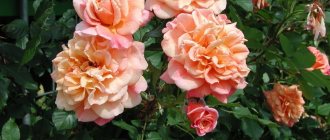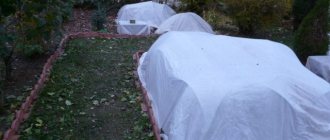Of all the flowers, roses are considered the most revered in the world. They are symbols of countries, they are depicted on coats of arms and even give them magical properties. It is believed that roses grown in the yard help you find true love. A flower growing on a windowsill cleanses the house of negativity and brings harmony to it. Climbing roses have become especially popular in landscape design. They are used to make intricate compositions, use them to create hedges, and decorate arches and pergolas. But it happens that a climbing rose does not bloom. The sooner gardeners understand the reason, the greater the chance of saving the plants.
Types of climbing roses
Roses with long shoots occupy a leading place in decorative landscaping. These semi-shrubs are grown in gardens near gazebos, arches, on balconies, cottages, and used to decorate interior spaces. Fixed on trellises and supports, they can serve as a hedge and shade the southern sides of houses.
Climbing rose on a trellis blooms all summer
Based on the size of the stems they are divided into:
- semi-climbing with stems up to 3 m long;
- climbing with branches up to 5 m;
- climbing, reaching 15 m in height.
According to the nature of their flowering, they can be large- or small-flowered; according to their tolerance of low temperatures, they can be heat-loving and winter-hardy.
Climbers
Climbing climbers have thick, hard, erect shoots. They don't have to weave around the support. They will cover a fence or an old wall without additional structures. Climber inflorescences can reach 7-11 cm in diameter; on one plant they bloom two to three times a year.
For your information! The name “climber” comes from the words “climber”, “climbing” (climber, mountaineering); sometimes this type of rose is called climbing, which is not a mistake.
Often, climber owners cannot understand how to make a climbing rose bloom, because they do not take into account that this type of plant requires reliable shelter in cold winters or cultivation in protected ground. Climbers form buds both on last year’s stems and on shoots that appeared during the flowering season.
Ramblers
Roses with the longest prickly curly and flexible vines belong to the group of ramblers (“ramble” - crawl, curl). Used for vertical gardening. They have small simple or semi-double inflorescences with a diameter of up to 2.5 cm, collected in bunches. They can bloom once a season, but are pleasing to the eye for 30 days. The leathery, dense foliage of rambler roses is also small in size. The root system does not freeze out under a thick layer of snow.
For lush flowering, these shrubs need a variety of supports; on them they can drive their branches up to the roof of the house. Distinctive features of ramblers are their flowering on last year's shoots and a very strong, beautiful aroma. Different varieties of these roses bloom at different times, so sometimes gardeners plant 2-3 species on one support, blooming alternately.
Note! In autumn, seed seeds are formed on ramblers on flowering stems, shaped like rosehip boxes.
Ramblers can grow to the roof of a house
RESPONSIBILITY: RESPONSIBILITY
OPTIONAL RESEARCH RESULTS Ð °ÑвеÑаÑÑ Ð¸ÑклÑÑиÑелÑно на вÑоÑой год, напÑи меÑ, Ñоза-ÑамблеÑ. RESULTS, RESPONSIBILITIES ´Ð°Ð²Ð°ÑÑ Ð¼Ð¾Ð»Ð¾Ð´Ñм Ñозам ÑвеÑÑи в пµÑвÑй год, ÑÑ RESULTS ¸Ð¶Ð¸Ð»Ð¸ÑÑ Ð½Ð¾Ð²Ð¾Ð¼ меÑÑе как можно лÑÑÑе.
RESULTS ASSURANCE RESEARCH ³Ð´Ð° в ÑÐ »Response еÑением.
Why does a climbing rose grow tall next year but not bloom?
You need to think about why the climbing rose does not bloom the next year after planting the seedling in a permanent place of cultivation. Sometimes the cause of concern is the fact that the plant does not form the number of buds that was promised by the characteristics of the variety. Often the plant grows long lashes covered with leaves, and the inflorescences open only at their tops.
Why does daylily not bloom and grow poorly?
Factors influencing the abundance of flowering:
- mistakes made when planting roses;
- improper care of plants.
Important! Experienced flower growers claim that everything can be fixed, and if the root system of climbing roses is not damaged, then everything can be corrected and the roses can be made to grow and bloom the way their owner wants.
Climbers are most often planted near the fence
RESULTS: RESPONSIBILITY: RESULTS
RESULTS ASSURANCE, ASSURANCE ·Ñ плоÑо пеÑеноÑÑÑ ÐºÐ¾Ð½ÐºÑÑенÑÐ¸Ñ Ñ дÑÑгими Ñа ASSURANCE, ASSURANCE, ASSURANCE, ASSURANCE, ASSURANCE °Ð´ÐºÐµ за Ñозами Ñдобнее ÑÑаживаÑÑ.
RESULTS, RESULTS, RESULTS ROCK, SMALL. RESULTS, ASSURANCE, ASSURANCE о, ÑкоÑее вÑего, они ÑгнеÑаÑÑ Ð½Ð°ÑÑ ÐºÑаѰви ÑÑ, оÑбиÑÐ°Ñ Ñ нее пиÑаѵлÑнÑе веÑеÑÑва и вла that's it.
Mistakes made by beginners when planting climbing roses
Several mistakes may be made during landing. All of them can significantly affect the development of young bushes and their further ability to flower.
Incorrectly selected soil composition and planting site
Climbing rose Casino - what kind of variety is it, characteristics
The choice of planting site depends on the varietal characteristics of the seedlings. Ramblers root well and grow in partial shade, but they need a lot of light to bloom. Climbers need sun in the first half of the day, but their thin leaves and inflorescence petals may not withstand the midday heat. Therefore, gardeners consider the best place for climbing roses to be an area at least 50 cm away from the walls of buildings (so that the heat from heated bricks does not scorch the plants), well ventilated, but protected from drafts and scorching sun.
The soil for plants should consist of permeable loam, since an excessively fertile soil composition can lead to an active growth of green mass to the detriment of the formation of flower buds.
Note! Excess nitrogen fertilizers or natural organic components in the soil lead to fattening of the bush and do not encourage it to form flower buds.
Stagnation of moisture can lead to rotting of the root system and weakening of the flower. To prevent waterlogging of the soil, it is necessary to add a layer of coarse river sand to clay soil. 2-3 months before planting, fertilizers with potassium-phosphorus components and biological products are added to the planting hole to prevent fungal diseases.
Insufficient penetration of the seedling into the planting hole
Seedlings of climbing roses can be obtained from cuttings of a certain type of plant, these are self-rooted flowers, or they can be grafted onto rose hips. If, when planting a grafted seedling, the soil does not cover the stems of the grafted flower, then new young shoots may begin to grow from the root of the mother stock, and not from the cultivated scion. In this case, flower buds will be formed on the stems of the rose hips, not the roses.
Scheme of planting a grafted seedling in the soil
Excess nitrogen fertilizers
Climbing roses in the garden may not bloom due to nitrogen oversaturation. Nitrogen fertilizers must be applied at the beginning of the growing season to stimulate the growth of shoots and foliage. At other times, fertilizing containing nitrogen should be avoided, otherwise the rose will abundantly grow green mass, which is why it will not have enough strength to bloom.
It is better to fertilize the soil with potassium salt with superphosphate or use wood ash. In the fall, in order to prepare the plant for wintering and to promote good flowering next year, phosphorus-potassium preparations are added.
In addition to the above, there are a number of other factors due to which the climbing beauty does not bloom. These include:
Wrong choice of place for rose growth. The area allocated for growing a flower should be well lit. But it is worth remembering that a rose loves diffused sunlight, and direct rays of the sun can burn its petals and foliage. Therefore, the place must be chosen so that it is shaded during the hottest part of the day. You should also ensure that the area is constantly ventilated and protected from drafts and wind.
It is also important that there are no large plantings near the bush that will absorb moisture and nutrients. Incorrect watering. Often, especially beginners in gardening, water the rose only superficially, which is a mistake.
The bush needs to be watered abundantly so that the water flows deep into the soil and the root system can be saturated with moisture. Once every 10 days, 10-15 liters of well-settled or rainwater at room temperature should be poured under the bush. In hot weather, you need to water the rose once every 7 days. Watering should be done early in the morning or in the evening. Bad winter. The rose is considered a heat-loving plant and although most varieties are frost-resistant, it should be properly covered for the winter. Before sheltering, you must definitely get rid of the weeds growing next to the bush and remove all wild and damaged shoots. The bush needs to be hilled. Remove the branches of the climbing rose and pin them to the ground. The stems cannot be laid on bare ground; it must be covered with spruce branches or dry leaves. The top of the shoots should also be covered with pine paws and covering material in case of severe frosts. It is important to remember that the shelter must be able to ventilate, otherwise the rose may prohibit. Therefore, when covering a flower, it is necessary to provide for the possibility of an air gap. Not a quality seedling. One of the important rules for purchasing a seedling is to buy from a trusted seller. It is recommended to buy seedlings in nurseries, where quality is guaranteed. To choose a good seedling, you need to pay attention to its appearance and become familiar with the characteristics of the desired variety. You should choose seedlings that are young, under three years old, with a well-developed and healthy root system. The bush should have 3-4 strong stems with green bark.
There are a huge number of different varieties of roses, among which there are unpretentious roses, and there are also capricious beauties. Therefore, before growing a garden queen, you should study its varietal characteristics, and then provide it with proper care. Then the rose will delight with its delightful, eye-catching flowers and will become a wonderful decoration for any garden, rose garden or flower bed.
We also suggest watching a video about problems with rose blooms:
Possible mistakes when caring for climbing roses
Why does paniculate, tree-like, large-leaved hydrangea not grow?
For climbing roses, arrangement on supports, proper pruning of bushes before wintering, wintering conditions, watering and fertilizing are important.
Important! The success of caring for climbing roses largely depends on the type and variety of the plant.
Since there are currently remontant (re-blooming) varieties of ramblers and climbers that bloom once per season, when purchasing seedlings it is necessary to clarify what type of plants they are and all the necessary conditions for caring for them.
Lots of growth
The growth of stems and new shoots requires nutrition. New root shoots begin to develop next to the bush. If all unnecessary branches are not trimmed in time, the plant will turn into a shapeless bush and begin to grow wild. Energy will be spent on the development of greenery, buds will stop appearing.
Trim the root shoots close to the ground with sharp garden shears. Small branches with thorns and leaves are removed. Forming a neat bush will help you devote all your resources to flowering.
Pruning the bush in the spring rejuvenates the plant and allows you to increase the number of flowers. Weak, diseased, unproductive stems, as well as stems growing inside the bush, are cut off. Thanks to pruning, the inside of the rose is ventilated.
Trimming
Depending on the varietal characteristics, roses are pruned either once a year on the eve of wintering, or up to 3 times a year:
- Ramblers must be pruned no later than September. Healthy shoots older than 2 years are shortened to a length that makes it possible to roll them into a ring; those tending inside the bush are cut out completely. On young annual central stems, 1-2 well-developed buds are left;
- on climbers, when pruning, it is necessary to preserve the skeleton from shoots no older than 4 years. Side shoots are shortened. In the summer, 1-2 prunings are carried out to remove faded inflorescences and shorten side shoots.
Important! Drying, weak, damaged, dead branches of any type of rose are removed during the entire flowering season.
Scheme for trimming climbers
Preparing for winter
In warm regions, climbing roses provide insulation only in the root zone. In central Russia, rambler roses can also get by with only light insulation, while climbers need protection consisting of arches with covering materials stretched over them. In the conditions of the Urals and Siberia, all types of roses are covered in such a way that a 10-15 cm strip of air remains above the plants, and dense thick protective materials are placed on the covering structure.
Note! Covering too early can lead to the damping off of flower buds that have been laid in the fall. Roses begin to protect against the cold at a time when frosts set below −5 ° C.
Warming ramblers for the winter
Watering and fertilizing
Climbing flowering roses with a large mass of branches require weekly abundant watering in the heat. In early spring, watering begins after the soil has completely dried. They are stopped in the fall. In winter, plants should leave with a slightly moist root zone.
Along with the first spring watering, nitrogen fertilizers are applied to the root zone. Their number depends on the size and age of the bush. On average, 15 g of urea is diluted in 10 liters of water. After 2 weeks, when watering, use nitroammophoska, which contains equal shares of nitrogen, phosphorus and potassium. In summer, plants will benefit from phosphorus and potassium for the formation of buds. For the winter, up to 3 kg of rotted manure is applied under each adult bush.
What else can affect flowering?
Why does a rose turn into a rose hip - how to fix it
Sanitary pruning of the bush and fertile soil play an important role in the growth and flowering of the rose bush. But there are some other factors that influence the formation of flowers.
Pest and disease damage
Climbing rose bark cancer
The reason why a climbing rose refuses to bloom may be a plant disease. Rose bushes are most often susceptible to diseases such as powdery mildew or bark cancer. If a disease is detected, the necessary measures are urgently taken to save the bush:
- against powdery mildew, dormant buds and branches are sprayed with a 1% solution of Bordeaux mixture, the same solution can be used for preventive purposes - there will be no harm to the plant;
- Feeding with potassium fertilizers (superphosphate and potassium sulfate), as well as correct and timely covering of the bush for the winter, pruning affected shoots and excess growth, and, as necessary, ventilating the covered roses for the winter, will help fight bark cancer.
Damage to pink shoots by powdery mildew
Bad landing site
Sometimes gardeners, due to inexperience, begin to grow their first rose bushes in a place completely unsuitable for a royal flower. This can lead to a lack of flowering or death of the plant.
Important! Climbing roses do not tolerate drafts and shade, but excess sun is also harmful to the flower. The hot sun can burn tender buds
Rules for planting climbing roses for full flowering:
- The planting site is chosen with good lighting, but so that at noon the sun's rays do not hit the plant.
- Climbing rose bushes must be protected from the north wind, otherwise the plant will not bloom in the cold.
- The plant does not like any proximity, especially with trees. They should grow in an area away from the bushes.
A well-chosen planting site for a bush is important for flowering
Wrong wintering
Plants require careful care not only in summer, but also in winter.
It is important to properly prepare the bushes for wintering, to make a special shelter so that they do not die from cold or dampness during winter thaws. There must be an air gap between the shelter and the bush
Preparation for winter begins at the end of summer, when loosening the soil and frequent watering are stopped, nitrogen fertilizing is excluded, all excess growth, as well as weak or damaged shoots, are cut off.
A low-quality seedling or the wrong variety was purchased
In pursuit of an inexpensive seedling price, inexperienced gardeners may encounter the fact that the young plant will not meet quality standards and, as a result, the rose will not bloom.
When purchasing, it is better to choose trusted nurseries that are confident in their plants.
It is also important to take into account the type of rose, since each climate zone has its own varieties. An incorrectly selected variety will not produce the expected flowering in an unsuitable climate.
Disease and pest control
Leaf-eating insects and their larvae, aphids, and spider mites are dangerous for roses. Plants may suffer from fungal diseases. Modern means of plant bioprotection make it possible to get rid of pests and various pathogenic microorganisms without harming the environment.
Important! It is necessary to carry out preventive treatment of plants in a timely manner, and do not leave pruned damaged branches near the bushes.
Gazebo of climbing roses
Wild growth
Very often, weaving wild shoots form at the base of the bush, which absorbs nutrients, which prevents the rose from fully blooming. Therefore, it is necessary to promptly trim all wild thorny shoots to their very base. The cut areas should be treated with powdered charcoal.
In addition, weak shoots that do not form buds should be trimmed, dried and wilted flowers should be removed until the petals completely fall on them. In the spring, after the last frost, it is worth carrying out sanitary pruning and thinning out very dense bushes. It is worth remembering that the circumcision instrument must be sharp and disinfected.
How to make a climbing rose bloom
For lush flowering, the rose must lay a sufficient number of flower buds on side shoots located horizontally above the ground. Correct pruning and horizontal tying to supports will lead to the growth of flowering side shoots on the central branches, and spring-summer feeding with phosphorus and potassium will give the plants strength to flower.
Beautiful flowers in the garden do not grow on their own. They need constant care and timely agrotechnical measures. These judgments fully apply to climbing roses, which are undoubtedly excellent ornamental plants.
Fertilizer
Flaw
A lack of nitrogen causes the leaves to turn pale, and red dots appear on them (especially old ones). A reddish tint on dark green leaves may indicate a lack of phosphorus (if this color is not expected by the variety itself), and purple spots may also appear on them. The lack of this substance slows down the growth of shoots and roots, flowering occurs later and more sparingly. Lack of calcium retards root development, weakens stems and leaves, causes disease and can lead to dieback.
Lack of nutrition
One of the common complaints is “the rose’s leaves are turning yellow and falling off - what’s the matter?” may be due to nutritional deficiencies:
- Pale shade of leaves along the central vein , young leaves are too light, leaves fall off, shortened shoots, weak growth, weak flowering or its cessation altogether - lack of nitrogen. It is worth carrying out foliar feeding.
- Gradual yellowing between the veins (the veins and a small area along them remain green) is chlorosis, a lack of iron.
- Spots and yellowing of the leaf blade between the veins , the veins themselves are bright green - lack of potassium.
- Yellowish spots with a burgundy tint and sagging are rare - this is a lack of phosphorus.
Fertilizers should be taken especially carefully shortly before flowering, during the formation of buds and - a moment that many people forget about - after flowering. It is likely that the reason the rose has no flowers is that it exhausted its strength last time and now simply cannot recover.
Why else can leaves turn yellow and fall off?
In addition to the lack of nutrients, there are three more main reasons: disease, overwatering, underwatering . We discuss the first one below.
Underwatering is an obvious problem: drying out soil and dry, yellow lower leaves that fall off, while the petiole is dry, and the tips of such leaves have begun to dry out. Very often this problem is confused with another - soil soaking . When the roots get wet and overwatering (perhaps the plant is planted in too dense soil), the roots begin to die, the leaves lack nutrition, they turn yellow, but a little differently than during drought. They seem to lose their tone, become soft (not brittle), fall off without losing elasticity, that is, the petiole of the fallen leaf will be soft to the touch.
A flooded plant needs urgent resuscitation (removal of rotten roots, treatment, planting in fresh soil, careful observation and care), otherwise it will completely die in the near future.











